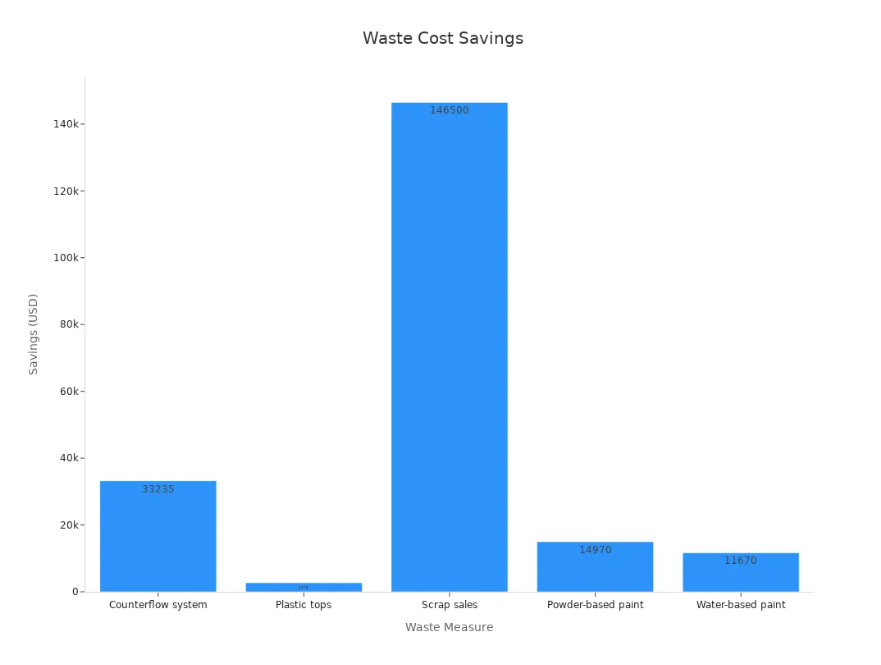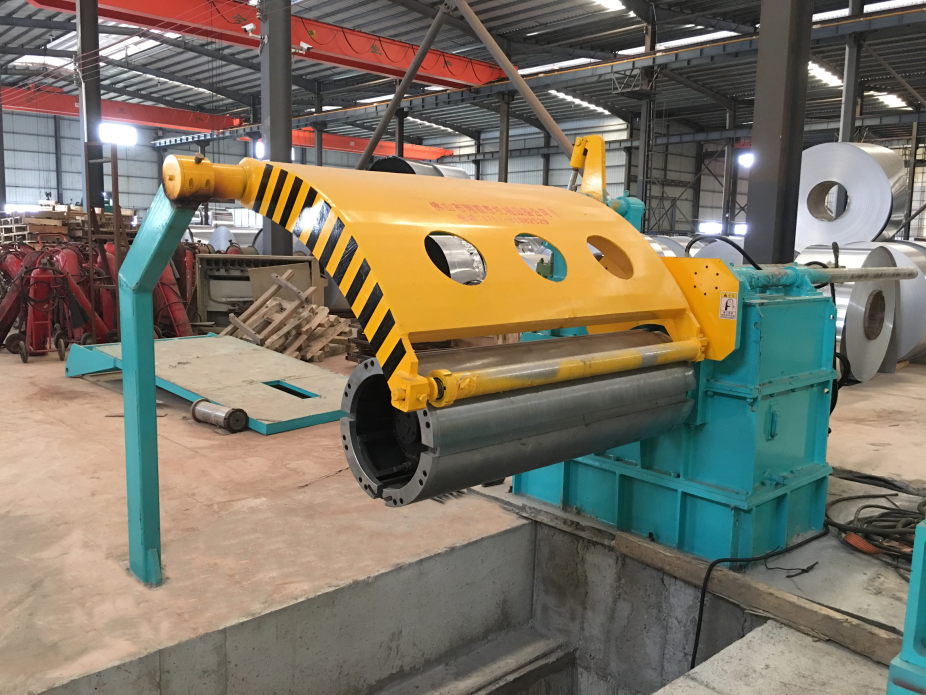Why Manufacturers Choose Dedicated Slitting Lines for Aluminum Coils?
Imagine a manufacturer who gets parts rejected for bad coil widths or rough edges. A slitting line for aluminum coils helps fix these problems. Operators notice better results every day. Automated systems make sure the widths are always the same. Edge trim removal units give smooth and exact edges. Sensors and quality control devices find problems early. These features help other steps like stamping and tube making. This saves time and stops expensive mistakes.
Key Takeaways
- Dedicated slitting lines cut aluminum coils very accurately. They make smooth edges and exact widths. This helps make better products and fewer mistakes.
- Automation in slitting lines makes production faster. It needs fewer workers and less downtime.
- Special handling and packaging keep aluminum coils safe from harm. This stops damage and rust. It saves money and cuts down on waste.
- Using dedicated slitting lines helps companies waste less. They save materials and spend less on repairs. Good design and recycling help with this.
- These machines can work with many aluminum grades and widths. They help manufacturers meet different customer needs. They do this safely and reliably.
Precision and Quality
Edge Quality
Manufacturers want every aluminum strip to have smooth edges. A dedicated slitting line for aluminum coils helps make this happen. It uses special blades and controls tension very carefully. Operators see that burrs are very small. The edges do not get bent or damaged. This is important because rough edges can cause jams or problems later.
Note: Industry standards help check edge quality. Two common standards are ASTM E340 and ISO 16160. These standards use tests to look at the cut edge after slitting. The table below shows how each standard checks edge quality:
|
Standard |
Material/Application |
Description of Edge Quality Evaluation |
|
ASTM E340 |
Metals and alloys (including aluminum) |
Uses macroetching techniques to quantitatively assess cut edge quality |
|
ISO 16160 |
Continuously hot-dip coated steel sheets (general metal slitting relevance) |
Specifies edge quality evaluation after slitting operations |
Meeting these standards makes sure every coil is good. It also helps coils pass quality checks.
Tolerances
Precision is important at every step. A slitting line for aluminum coils can cut with very tight tolerances. This means each strip is almost the exact right size. The strips fit well in stamping presses or tube mills. When tolerances stay the same, machines work faster and stop less.
- Keeping the width the same lowers scrap.
- Accurate slitting stops parts from being out of place.
- Good tolerances help fast production and keep quality high.
Manufacturers who use dedicated slitting lines have fewer bad parts. Their work goes smoother. They become known for sending good products on time.

Guider Device
Efficiency and Productivity
Throughput
A slitting line for aluminum coils helps companies cut big coils into smaller strips fast. These machines can work at high speeds, measured in meters per minute. Operators can make many strips from one coil in just one pass. This means more strips are finished in less time.
Tip: Automation lets one or two technicians run the whole line. This saves money on workers and keeps things steady.
The table below shows important efficiency features:
|
Efficiency Metric / Feature |
Description / Impact |
|
High speeds help process more coils each shift. |
|
|
Number of Cuts per Pass |
Making many strips at once helps get more done. |
|
Hands-Free Strip Threading |
Automatic threading makes things safer and faster. |
|
Operator Requirement |
Fewer workers are needed because of automation. |
|
Integrated Handling Systems |
Automated unloading and moving systems make packing and shipping faster. |
Downtime
Companies lose money when machines stop working. Dedicated slitting lines for aluminum coils use automated blade changes. These changes take less than four minutes, so work starts again quickly.
Digital systems like MES or SCADA help operators watch every step. These systems check quality and find problems early. This means machines stop less, and work stays on track.
- Fast tool changes mean less waiting.
- Automated systems keep things moving.
- Digital controls help stop surprise problems.
Companies using these lines finish more products and have fewer delays.
Material Protection
Surface Care
Aluminum coils must be handled with care to stay clean. Dedicated slitting lines use special systems to protect the coil surface. Operators see padded rollers and soft guides that stop scratches. Machines keep the tension even, so the coil does not slip. This helps prevent marks and dents on the product.
Manufacturers use special packaging to keep coils safe from dust and water. Barrier materials with low water vapor rates keep water out. Some lines put vapor corrosion inhibitors and desiccants inside the package. These features stop stains and rust before they start.
Tip: Storing coils inside in dry, airy places gives more protection. This easy step keeps the surface shiny and clean.
Aluminum Properties
Aluminum is soft and needs extra care. It can bend or change shape if not handled right. Dedicated slitting lines use strong packaging and careful handling to stop problems like ovalization or telescoping. These problems can cause waste and slow down work.
Operators follow strict rules when lifting and moving coils. They use the right tools and enough strapping to keep the coil’s shape. Keeping winding tension steady during slitting also helps protect the coil.
· Material protection steps in dedicated slitting lines include:
- Storing coils inside to keep out moisture.
- Using barrier packaging with vapor corrosion inhibitors and desiccants.
- Using the right strapping and lifting methods.
- Keeping winding tension even.
These steps lower damage and cut the risk of defects. Manufacturers get fewer bad coils and do less rework. Good protection saves money and keeps work on time.
Cost Savings
Waste Reduction
Dedicated slitting lines help companies make less waste. These machines use exact controls to cut down on scrap. Operators see less leftover aluminum after each job. Selling scrap aluminum and steel brings in extra money. For example, selling 250,000 pounds of scrap each year makes over $146,000.
Other ways to cut waste, like using powder coating or recycling cutting fluids, also save money. The table below shows how different steps can save money each year and how long it takes to get the money back:
|
Waste Reduction Measure |
Annual Cost Savings (USD) |
Implementation Cost (USD) |
Payback Period |
Additional Details |
|
Replace chlorinated hydrocarbon solvents |
$62,640 raw material + $6,007 disposal |
$20,700 |
~4 months |
11,000+ gallons solvent used annually; 92-98% lost to evaporation |
|
Convert rinse tanks to counterflow system |
$33,235 |
N/A |
~1 month |
Water use reduction by not feeding idle rinse tanks |
|
Switch to electrostatic powder coating |
$22,885 raw material + $5,869 disposal |
$100,640 |
3.5 years |
Reduces waste solvents, water, paint solids, plastic liners, spray booth coating |
|
Use lightweight plastic tops to cover greasing units |
$2,675 |
$3,600 |
~1 month |
Reduces solvent evaporation |
|
Scrap aluminum and steel sales |
$146,500 |
N/A |
N/A |
Approximately 250,000 pounds of scrap sold annually |
|
Replace solvent-based painting with powder-based |
$14,970 total |
$20,600 |
1.4 years |
Waste reduction: 72 gal paint sludge + 66 gal spent thinner |
|
Replace solvent-based painting with water-based |
$11,670 total |
$2,500 |
0.2 year |
Waste reduction: 72 gal paint sludge + 66 gal spent thinner |
|
Recycle cutting fluid onsite |
N/A |
N/A |
N/A |
Extends cutting fluid life, reduces waste volume |
|
Waste reduction of 3,114,290 gallons/year |
$11,120 raw material – $3,840 operation = $7,280 net |
$56,380 |
7.8 years |
Large volume waste reduction |
|
Waste disposal and raw material cost savings |
$24,460 disposal + $6,250 raw material – $8,000 operation = $22,710 net |
$70,000 |
3.1 years |
Significant cost savings from waste reduction |

With dedicated slitting lines, companies often get their money back from waste reduction in less than a year.
Maintenance
Dedicated slitting lines for aluminum coils help lower repair costs over time. These machines use strong materials and smart designs to last longer. Operators spend less time fixing things and more time making products. Aluminum’s natural oxide layer and special coatings help parts last longer. This means fewer new parts and less machine downtime.
- Cast aluminum parts use less material, so they cost less.
- Lighter aluminum parts make shipping cheaper.
- Corrosion resistance helps parts last longer and need fewer repairs.
- Lighter parts use less energy, so companies save power.
- Recycling aluminum uses only 5% of the energy needed for new metal.
Many studies show that recycling and good maintenance save money. New recycling methods skip energy-heavy melting and keep aluminum strong. These steps help companies stay ahead and protect the planet.
Doing regular maintenance and recycling helps save money and keeps work running well.

Recoiler
Slitting Line for Aluminum Coils
Custom Widths
A slitting line for aluminum coils lets manufacturers make strips in any width. This helps them use the strips for many things, like car parts or HVAC fins. Operators can set the machine to cut narrow or wide strips. They do this based on what the order needs. The equipment uses sensors and controllers to move the blades very accurately. Some systems can measure as small as 0.015875 mm (0.000625″). This makes sure each strip is the right size.
Modern slitting lines use PLC and HMI. These systems save settings for different coil widths. They also use sensor data to make changes right away. Operators can switch jobs fast. This means less waiting and more work done. Modular designs help the machines change for new products or upgrades. Manufacturers often work with suppliers to build machines that fit their needs.
Note: Handling and packaging systems can change for different coil widths and materials. Features like barcode or RFID and non-contact centering help process each coil quickly.
· Key features that help make custom widths:
- Rotary knives with spacers to size strips
- Blade alignment and tension control
- Modular design for easy changes
- Real-time width checks and digital monitoring
A slitting line for aluminum coils makes sure every customer gets the right size material.
Application Flexibility
Manufacturers must keep up with changing customer needs and materials. A slitting line for aluminum coils can handle these changes easily. The equipment works with many aluminum grades, from soft to strong. Operators use PLCs and sensors to set speed, tension, and blade angles for each grade. This keeps quality high, even with thin or special alloys.
Material handling tools, like hydraulic mandrels and automatic threading, make setup faster. Looping pits and tension stands keep the coil tight and stop problems like wavy or torn edges. Real-time monitoring and IoT sensors collect data on how the machine and material act. Operators use this data to make quick changes. This helps cut better and lowers downtime.
· Application flexibility features include:
- Blade angle changes for different alloys
- Self-sharpening rotary knives for steady quality
- Quick-change tools for fast job switches
- Scalable modules for future needs
A slitting line for aluminum coils helps many industries, like automotive, construction, packaging, and electronics. Being able to process many grades and sizes helps manufacturers stay ahead in a fast market.
Reliability and Safety
Long-Term Use
Manufacturers need machines that work every day. Dedicated slitting lines for aluminum coils are built to last many years. These machines have strong steel frames and precise parts. Engineers make them to handle heavy work all the time. Operators notice the machines do not break down often. They are made to resist damage from daily use.
Built-in tools help with regular maintenance. Sensors watch the blades, motors, and bearings. If something needs fixing, the system sends a warning. This lets teams fix small problems before they get worse.
Tip: Checking and cleaning the machines often helps them last longer.
Many manufacturers say their slitting lines work for decades. They can update the software or add new parts as needed. This means companies do not have to buy new machines often. They save money and avoid stopping work.
Safety Features
Safety is important in every factory. Dedicated slitting lines for aluminum coils have many features to keep workers safe. Emergency stop buttons are easy to reach. Safety guards cover the moving blades and rollers. Light curtains and sensors stop the machine if someone gets too close.
Operators learn how to use the machines safely. Warning labels and color-coded controls help stop mistakes. The table below lists common safety features:
|
Safety Feature |
Purpose |
|
Emergency Stop Button |
Stops the line instantly |
|
Safety Guards |
Blocks access to moving parts |
|
Light Curtains |
Detects entry into danger zones |
|
Lockout/Tagout Points |
Ensures safe maintenance |
Note: Following safety rules keeps people safe and work on track.
Manufacturers trust dedicated slitting lines to protect their teams. Good safety systems lower accidents and help build a safe workplace.
A slitting line for aluminum coils helps manufacturers do better. They get more accurate cuts and work faster. The material stays safe from damage. Companies save money and can handle new jobs easily. Studies show these machines help companies beat others. Experts say it is important to get good results and try new ideas. Leaders who pick dedicated equipment help their business grow for many years. They also get ready for new changes in the future.
FAQ
What is a dedicated slitting line for aluminum coils?
A dedicated slitting line is a machine that cuts big aluminum coils into smaller strips. It uses sharp blades and special controls. Each strip comes out the right width and has smooth edges.
How does a slitting line improve production speed?
A slitting line can cut many strips from one coil at once. Automated systems move the strips fast. Workers do not have to move things by hand as much. This means more strips are made in less time.
Can a slitting line handle different aluminum grades?
Yes, it can. Modern slitting lines change blade settings, tension, and speed for each aluminum grade. Operators pick the right settings for every job. This keeps the quality the same for all strips.
What safety features do these machines include?
Safety guards cover moving parts. Emergency stop buttons are easy to reach. Light curtains stop the machine if someone gets too close. Sensors check if the machine is working right. These features help keep everyone safe.
How does a slitting line reduce waste?
A slitting line uses exact controls to cut just what is needed. There is less leftover aluminum after cutting. Companies save money by selling scrap and not paying as much to throw things away.

